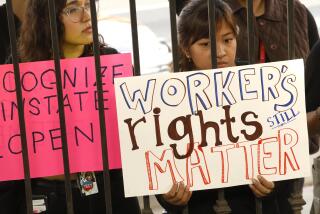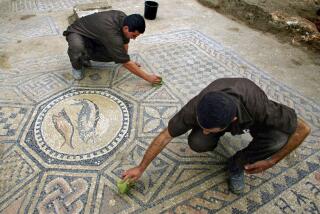Archeology Museum Tries to Dig Out of Hole
- Share via
ANDOVER, Mass. — It was 64 years ago that 11-year-old Eugene Winter first came to the Robert S. Peabody Museum of Archaeology and lost himself among the thousands of American Indian relics.
He spent his days collecting artifacts in the woods and riverbeds, imagining the world before Europeans arrived. Once, he sewed together a tepee from canvas patches and slept in it 138 nights to find out what life back then was really like.
The museum was love at first sight, and love for life.
As a volunteer, he has given hours to the Peabody: teaching archeology to locals, exploring ruins with museum directors, fielding calls from farmers and construction workers who stumble onto a find.
But the Peabody has been more than one man’s toy box. It holds a 500,000-piece collection that archeologists call one of the most significant in the field. And many consider it a shrine to the modern science of archeology, thanks to pioneering research by a series of Peabody directors.
But the Peabody’s future is in jeopardy. Its 101-year history has seen fantastic discoveries but also money problems and disagreements with Phillips Academy, the boarding school across the street, to which it is bound through Robert Peabody’s will.
A committee at the school, commonly called Andover, is contemplating the Peabody’s future on behalf of the academy’s board, which also oversees the museum. According to committee Chairwoman Rebecca Sykes, it will likely recommend dispersing much of the collection to be cared for by other institutions, perhaps keeping a small core for student use.
Staff cuts have left just two full-time employees, but salaries, utility bills, exhibits--all necessary to the day-to-day upkeep of the museum--are still eating up $100,000 a year. Andover, despite its own $500-million endowment, says it cannot continue to bail out the museum. It would take at least $6 million to endow it properly.
There’s no talk of selling the Peabody.
Still, some members of the Society for American Archaeology have written letters urging Andover to support the museum.
Winter isn’t giving up hope that the Peabody will survive, but he knows the future is dim. The heating pipes in the empty hall where he recounts his days groan through the dilapidated walls of a two-story building that needs millions of dollars in repairs.
There’s no fire escape, so the staircase to the upstairs library is roped off.
*
A Vision of Brushing Away Old Myths
Robert Peabody was an Andover and Harvard man, but he envisioned archeology as more than a hobby for Victorian-era gentlemen. He wanted it to be a science that would brush away myths of the past, and he wanted Andover at the vanguard.
“This was a unique idea when Robert Peabody proposed it: to have in a high school, not a college, a science museum that would fascinate kids,” says Jim Bradley, the museum’s director from 1990 until last year. “He said high school is the time when you grab students’ attention.”
Peabody directors like Alfred V. Kidder and Richard MacNeish put the museum on the cutting edge of archeological research. Kidder pioneered the technique of stratigraphy, which scientists use to examine an archeological site in layers and get a full picture of what it may have looked like at a particular time.
His nine years of digging at a site in Pecos, N.M., helped fulfill Peabody’s vision of changing archeology from a hobby to a systematic science that borrowed from other disciplines like geology and ethnography.
In 1954, a conference in the Peabody building was the scene of early discussions about carbon-14 dating, a technology that measures the radioactive decay of carbon to determine the age of artifacts. It revolutionized the field.
Expeditions and donations expanded the Peabody collection to 500,000 artifacts, including textiles ranging from Eskimos’ sealskin boots and parkas to holiday garb from Peru and Mexico, and a vast assortment of knives, axes and other tools from the Arctic through South America. A handful are on display--among them, a spoon signed by Sitting Bull and a row of small, then progressively larger, corncobs that measure the American Indians’ progress in hybridizing the plant.
“The collections are of inestimable importance,” says Dena Dincauze, a former president of the Society for American Archaeology, which was founded in the Peabody.
*
Few Courses Have Used the Collection
But though the museum’s research flourished through the 1970s, Peabody’s dream of a close connection with the school never fully materialized. Few teachers have incorporated the collection into course work.
“The school and the museum have operated often on parallel tracks,” Sykes said. “Not really in conflict with each other, but simply having very different missions.”
It’s a polite interpretation. People familiar with the museum’s history say not a single director has left the job in circumstances other than a spat with the school. Money has been a consistent struggle. In 1909, the museum had about $480,000 in its coffers, but that has grown to just $1.5 million. Andover officials couldn’t say precisely what the school’s endowment was in 1909, but it has grown to more than $500 million.
How did the finances of two institutions, governed by the same board, fare so differently? The school says the Peabody’s initial funds were more a gift than an endowment, so the museum was more inclined to spend than invest. During the 1990s, the Peabody was dipping into its principal to pay bills. And because few students had ties to the museum, there was only a small constituency of alumni supporters.
Privately, museum supporters say they can’t raise money because of uncertainty about the facility’s future.
*
Cheaper for Andover to Endow the Museum?
But Andover says the school has been generous, spending $100,000 or more per year during the past decade. Tuition runs $26,900 a year, and 39% of students are on financial aid. That $100,000 could provide three full scholarships.
Sykes says the collection would be dispersed only to someone who could care for it properly. But Bradley doubts that anyone willing to take on the work could be found. He also thinks it would be cheaper for Andover to endow the museum.
Sykes says Andover would welcome a donor stepping forward to save the museum. She said $6 million to $12 million would do it. But a message on the school’s Web site says the Peabody would need $8 million to endow its current budget, and requires $3 million to $4 million in repairs.
If the Peabody closes, Winter says, he’ll probably find another place to volunteer. Until then, he stops by a couple of days a week.
“On the one hand, we have to try to save the museum,” he says. “But if that doesn’t turn out, the most important thing is to try to save the collections, which are irreplaceable.”
More to Read
Sign up for Essential California
The most important California stories and recommendations in your inbox every morning.
You may occasionally receive promotional content from the Los Angeles Times.













